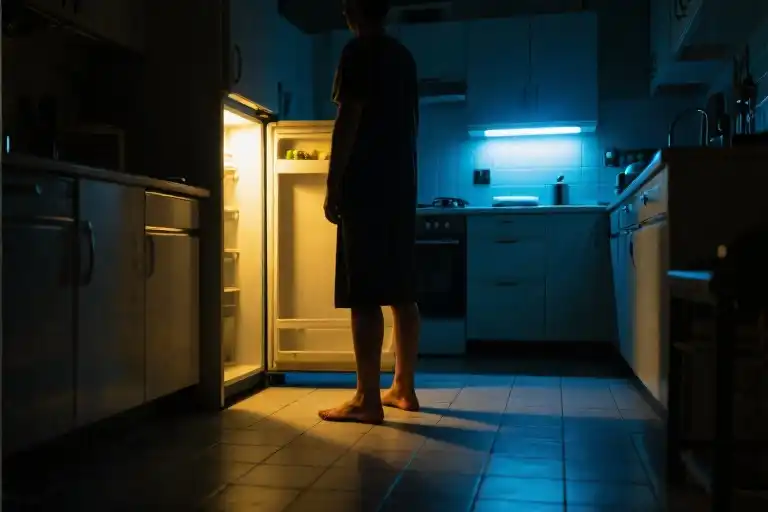The glow from the refrigerator at 3:17 AM casts long shadows across your kitchen floor. You’re not here for a midnight snack – you’re standing barefoot on cold tiles because sleep abandoned you again. That familiar tightness wraps around your chest like invisible hands squeezing what’s left of your resolve.
Here’s what you need to hear right now: You’re not malfunctioning. This isn’t breaking – this is being human in a world that forgot to include an instruction manual for emotional survival. For the next ten minutes, let’s suspend all those ‘shoulds’ and ‘musts’. You don’t have to fix anything, improve anything, or become anything. Just be here, with these words meeting you exactly where you are.
Seventy-six percent of urban dwellers experience these nocturnal battles with invisible depression – that persistent undercurrent of exhaustion running beneath their seemingly functional days. Maybe you’re part of this silent majority who smiles through Zoom meetings while counting minutes until you can disappear under blankets. Perhaps you’re the friend who comforts others while your own emotional reserves hemorrhage unnoticed. Wherever you are in this struggle, recognize this: Your pain speaks a legitimate language.
That pressure behind your sternum? It’s the accumulated weight of postponed breakdowns. The static in your thoughts? The white noise of a nervous system stretched beyond capacity. What if we treated these symptoms not as personal failures, but as physiological distress signals – the body’s equivalent of a smoke detector blaring through emotional wildfires?
Before we go further, establish this reading contract with yourself:
- Permission to feel without judgment (grab that box of tissues)
- Freedom from self-improvement agendas (no productivity hacks here)
- Ownership of your pace (pause whenever needed)
We’re not doing inspirational platitudes today. No ‘good vibes only’ toxic positivity. This is a sanctuary for the parts of you that ache without vocabulary, the exhaustion no caffeine can touch, the loneliness that persists in crowded rooms. The next few scrolls won’t erase your pain, but they might help you carry it differently.
(Your coffee cup from eight hours ago still sits half-full on the counter – a relic from when you last pretended to have energy. Let’s begin where you actually are.)
The Pain Translator: Mapping Your Emotional Landscape
Your exhaustion isn’t just in your mind—it’s in the way your shoulders slump like carrying invisible sandbags. That knot between your ribs when you force a smile in meetings? The tremor in your hands scrolling through endless notifications at 2 AM? These are real physiological responses to emotional overload, not signs of weakness. Let’s decode them together.
Your Body’s Distress Signals (Check All That Apply):
- [ ] Temple pressure that mimics a too-tight headband (chronic overthinking)
- [ ] Stomach folds when receiving criticism, like being punched with words
- [ ] Palm tingles during social interactions—your nervous system’s false alarm
- [ ] Eyelid twitches that sync with your racing thoughts at bedtime
- [ ] Cold feet even in warm rooms (circulation retreating from stress)
These sensations are your body’s morse code, signaling what your mind hasn’t articulated. That persistent fatigue isn’t laziness—it’s the emotional equivalent of wearing a soaked wool sweater day after day. The heaviness never dries, chafing your skin until you forget what lightness feels like.
The Wet Sweater Theory Explained:
- First Hour: Notice the discomfort (“I’m just tired”)
- Third Day: Numbness sets in (“This is normal now”)
- Week Two: The weight feels like part of you (“Maybe I’m just broken”)
This is how emotional burdens become invisible—not because they disappear, but because we stop recognizing them as foreign objects. Your body remembers what your conscious mind suppresses.
Permission Slip for “Unreasonable” Breakdowns:
Print this, tear it, or screenshot it—these are valid reasons to fall apart:
☑️ Crying because your toast burned
☑️ Rage-cleaning after a trivial inconvenience
☑️ Feeling devastated by a minor work feedback
☑️ Laughing uncontrollably at nothing
☑️ Hating a song you usually love
These aren’t overreactions—they’re pressure valves for accumulated strain. Like steam escaping a kettle, these moments prevent total system failure.
“What you dismiss as ‘dramatic’ is often your psyche’s last attempt to get your attention before going mute.”
Tomorrow we’ll excavate your hidden resilience. For now, try this: Press two fingers where your neck meets your collarbone. Feel that pulse? It’s been keeping time through every storm. Your body hasn’t quit on you—don’t quit on it.
2. Survival Archaeology: A Guide to Excavating Your Resilience
The Museum of Unrecognized Victories
Every life contains artifacts of quiet courage that never made it to the highlight reel. That week you dragged yourself to work despite the emotional flu? Artifact. The nights you chose tea over tears? Artifact. The mornings you whispered “one more day” to the bathroom mirror? Priceless exhibit.
Curator’s note: This is no vanity gallery. We collect what survival looks like when no one’s applauding:
- The unshared playlist titled “Songs That Kept Me Alive”
- The screenshot of a 3am text you wrote but never sent
- The grocery list with “bread” scribbled over dried tear marks
Touch the glass case. These belong to you.
The Anti-Achievement Inventory
Forget productivity metrics. We document different data points:
Room 1: The Grace Wing
- 11/14/23: Allowed self to nap instead of “being productive”
- 02/03/24: Said “I can’t” without apology
Room 2: Relapse Reliquary
- The pajamas worn for 72 straight hours
- The deleted draft emails containing raw truth
Special Exhibit: Threshold Moments
That exact second when hopelessness turned into “fine, one more step” – preserved in emotional amber.
Survivors’ Coalition Manifesto
You are:
- The child who fell off the bike and remounted
- The teen who survived cafeteria loneliness
- The adult currently reading this through tired eyes
This is your lineage of resilience. That time you Googled “emotional exhaustion remedies” at 2am? A survival tactic worthy of your ancestors’ pride. The “pathetic” Netflix marathon that kept you from worse choices? Strategic retreat.
Breathe in: You contain multitudes of survivors.
Breathe out: Their strength still flows through you.
Excavation Toolkit
Brush #1: Timeline Mapping
Draw your personal resilience history from:
- Age 7: Kept breathing after goldfish died
- Age 16: Endured heartbreak without dissolving
- Present: Reading this instead of surrendering
Brush #2: Artifact Analysis
Hold up any “failure” and examine its hidden facets:
- That abandoned project → taught you about boundaries
- That relationship ending → made space for self-meeting
Brush #3: Carbon Dating Pain
When current struggles feel eternal, recall:
- Last year’s “unbearable” thing you now barely remember
- The childhood sorrow that lost its sting
Interactive Exhibit
Which survival artifact deserves your belated recognition?
□ The shower where you finally cried
□ The notes app full of unsent letters
□ The saved meme that made hope flicker
□ The walk around the block that prevented collapse
Next display: Notice how your breathing changed when acknowledging these. That’s your nervous system recognizing truth.
Transition to Armory
These unearthed strengths aren’t relics – they’re blueprints for your next survival toolkit. Because the person who endured all that? They’re the same person reading these words now. And that person deserves proper equipment…
3. Emergency Toolkit for the Weary Soul
Your 5-Minute Emotional First Aid Kit
When the walls feel like they’re closing in, these micro-interventions can create breathing room:
- The 4-7-8 Breath Reset (For instant grounding)
- Inhale through your nose for 4 seconds
- Hold while silently counting to 7
- Exhale through pursed lips for 8 seconds
Pro tip: Place one hand on your sternum to feel the rhythm
- Wrist Shock Technique (When thoughts spiral)
- Run cold water over your inner wrists
- Alternate with 20 seconds of warm water
- The temperature contrast triggers mammalian dive reflex
- Anger Playlist Protocol (For suppressed frustration)
- Create a 3-song sequence: Rage → Catharsis → Calm
- Move your body aggressively during the first track
Building Your Emotional Body Armor
Layer 1: The Daily Shield
- Morning ritual: Stretch while listing 3 mundane victories (“Fed the cat on time” counts)
- Carry a textured “worry stone” for tactile grounding
Layer 2: Crisis Padding
- Pre-write comfort cards (“You survived 100% of worst days”)
- Designate a “scream spot” (park bench/shower)
Layer 3: The Invisible Cloak
- Develop code words with trusted allies (“Code blue” = need silent presence)
- Curate a “hope evidence” folder (screenshots of past recoveries)
Pain Decoder Manual
Use this flowchart when emotions feel overwhelming:
- Locate the sensation (e.g., “tight throat”)
- Translate to need (“I require safety”)
- Match intervention (Humming activates vagus nerve)
Sample Decoder Key:
| Body Signal | Possible Need | Immediate Action |
|---|---|---|
| Clenched jaw | Boundary setting | Chew gum aggressively |
| Heavy eyelids | Permission to rest | 90-second “micro-nap” |
| Numb fingertips | Sensory input | Rub hands on denim seams |
The Portable Sanctuary
Assemble these in a literal/physical kit:
- Taste anchor: Strong mint gum
- Scent trigger: Mini vial of familiar fragrance (childhood lotion/campfire scent)
- Visual talisman: Polaroid of your “future self” spot (that café you’ll visit)
- Audio lifeline: Voicemail from your most reassuring friend
Remember: These tools aren’t about fixing yourself, but about creating space to exist exactly as you are right now. Tomorrow’s weapons might look different – and that’s progress.
Time Capsule Instructions for Your Future Self
Right now, the weight you’re carrying feels permanent. But what if you could send today’s struggles forward in time – not as burdens, but as artifacts of your resilience? This is your guide to creating an emotional time capsule.
The Pain Museum Blueprint
Imagine walking through a museum where your current hardships are displayed behind glass:
- Exhibit A: The 3AM Thoughts Collection
Artifact: Your phone notes from sleepless nights
Curator’s Note: “Visitor frequently mistook temporary storms for permanent climate” - Exhibit B: The Invisible Labor Wing
Artifact: Faded metro card from commutes endured
Interactive Display: Touchscreen shows how many times you swallowed tears - Special Exhibition: Survival Tools That Seemed Too Small
Featured Item: Your “silly” comfort playlist
Did You Know? These became foundation stones for later joy
Postcard from Tomorrow
Write these three sentences as if future-you is speaking:
- “Back then, you couldn’t see that would lead to “
- “What felt like weakness was actually __“
- “Remember when __ seemed impossible? You’re doing it now.”
Pro Tip: Store this in your phone’s locked notes with today’s date. Set a reminder to reopen it in 6 months.
The Archaeology of Hope
Your future self will recognize turning points you can’t yet see. They’ll spot:
- The meal you forced yourself to eat (became energy for breakthrough)
- The deep breath you took (started rewiring panic responses)
- The tiny boundary you set (created space for better relationships)
Tonight’s Assignment: Sketch one object that represents your current struggle. In the corner, write “Future Exhibit Label” and imagine how it might be described years from now.
“The artifacts we preserve tell us less about the pain than about the preserver.” – Anonymous Museum Guest Book
(Leave 3 blank lines here)
When you’re ready, press your palm against this paragraph. The warmth is future-you high-fiving present-you through time.
The Closing Ritual: Where Your Journey Continues
Reach out and touch these words with your fingertips. Feel the slight warmth of your screen, the same warmth that’s been with you through every scroll, every pause, every shaky breath you took while reading. This is your moment – the quiet after the storm.
“I am enough” (say it aloud or whisper it to your heartbeat)
That blank space above? It’s not empty. It holds everything you couldn’t put into words tonight. The sighs, the unshed tears, the weightless hope you’re barely daring to feel. This is where your story continues when the screen fades to black.
For when the night feels longest, dial your local emergency mental health contact and hear this message:
“You’ve survived 100% of your worst days so far. This voice believes in you exactly as you are right now – messy, tired, perfectly imperfect. Breathe with me: 4 counts in… 7 counts hold… 8 counts out. Repeat until the world feels softer.”
❤️ Safety Note: While these words come from care, they’re not professional care. If the weight feels crushing, please reach out to your local crisis line – letting others help you carry the load is its own kind of courage.
(Scroll up and touch that blank space one more time before you go. We’ll keep the light on for you.)





